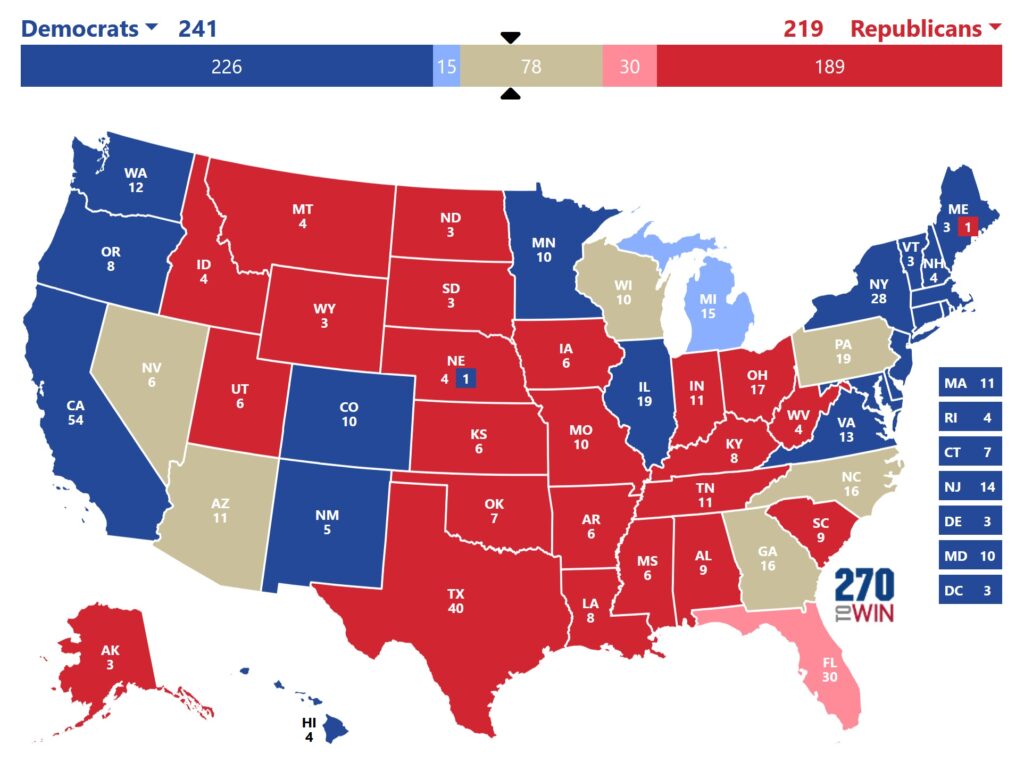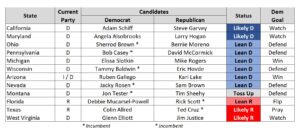I’ve been asked to revisit my analyses of the Senate and House races in addition to the Electoral College. The problem is that I just don’t have access to enough up-to-date data that accounts for the game-changing shift at the top of the Democratic ticket. I see no shortage of professional pundits weighing in, but I suspect their data isn’t all that much better than mine. They’re guessing. While I’m not above conjecture myself, I want to be clear about what I’m doing. If enough good data becomes readily available, I’ll look into the tedious effort of compiling it and performing a real analysis. No guarantees, though, since I’ll probably need to modify my predictive model. We’re in uncharted territory now and a lot of assumptions may no longer apply.
In the meantime, I’ll simply make a few broad observations, backed by only a smattering of solid data. I’ll end with my recommendations of where one might send campaign contributions for the best bang-per-buck.
As I’ve noted before (ad nauseam), every toss-up 2024 election – and there are a whole lot of them across the board – will now be won or lost by turnout. That also applies to the close races that currently lean one way or the other. It’s no longer about changing minds. Each party will flip a few voters before the election, but the net effect will be a wash. It’s the party that gets their voters to the polls that will win.
Trump is certainly doing his very best to help Democrats. He is so concentrated on firing up his extreme MAGA supporters that he’s alienating the rest of his own party. As numerous Republican politicians have recently noted, that’s not a winning strategy. Trump just can’t help himself. He’s resorting to personal attacks on everyone, going so far as to directly challenge even other Republicans whom he believes haven’t shown him sufficient deference. For example, he continues to attack the popular Gov. Brian Kemp (R-GA) in a swing state that the GOP absolutely needs to win. Kemp has actually endorsed Trump, and Kemp even enacted new voting laws that are designed to help Republicans in Georgia. However, Kemp apparently hasn’t bowed low enough and thus Trump continues to attack him.
On the other hand, Democrats are on an absolute roll. Party divisions are minimal and Harris has run a nearly flawless campaign. The first two days of the Democratic National Convention have gone extremely well and, if that trend continues, all Democrats should see post-DNC poll bumps. If the Harris campaign – and Democrats in general – can maintain the uncommon discipline they’ve shown thus far, at least some of those bumps might well persist into November.
Electoral College
Rather than burying the lede, I’ll start with a look at the Electoral College. While Harris hasn’t yet redrawn the map, she has certainly moved it – and has done so in less than a month. The 9/10 debate could be important, but Harris only has to keep calm, sound sane, maintain an upbeat tone, and refuse to be dragged into the mud by Trump.
My current guess is more optimistic for Democrats than most pundits are predicting. I think Harris has already moved three states toward the “D” side as compared to my April take. I’m thus moving NC from Lean R to Toss-Up, MI from Toss Up to Lean D, and VA from Lean D to Likely D. That’s all great, but we’re not there yet.
The Senate
Here, things appear to have only changed in the margins – slightly in the “D” direction, but not enough to warrant celebrations. Since my April take, I am moving MD from Lean D to Likely D and NV from Toss Up to Lean D. However, to retain control of the Senate, Democrats need to run the table with ALL of the Lean D races. AND they need to win a very tough Toss-Up race in MT. AND they need a Harris/Walz win to break the resultant 50/50 Senate tie. Whew.
The House
Sorry, but I need to punt here. The small amount of new data that I have on House races does appear to favor Democrats, but it’s nowhere near enough to draw any broad conclusions. For now, I’ll just have to stay with my April take, although I suspect that several races have moved. Enthusiasm at the top of the ticket should hopefully drive the turn-out necessary to push some more of the down-ballot races into the “D” column. We’ll see.
Money
We’re nearing the point where end-game campaign budgets are being finalized to fund the all-important get-out-the-vote efforts. Every dollar counts and contributions made now are worth far more than contributions made later.
That said, I thought I’d share (or re-share, in some cases) the places where I’m putting my own money.
I generally avoid contributing directly to the Democratic party itself. They tend to throw money everywhere – including spending on races that don’t really need help and on races that simply aren’t winnable. I understand the politics involved, but they can use other people’s money for that. I would consider sending money to swing-state party organizations, but I haven’t yet done the research to see how each is using their resources.
For now, here are my choices:
The top of the ticket.
The two PACs associated with the Democratic leaders of the House and the Senate. Both House Minority Leader Hakeem Jeffries and Senate Majority Leader Chuck Schumer are incented to spend money wisely to, respectively, keep and win a Democratic majority in the chambers they lead. Both have excellent political instincts, and both are armed with more up-to-date data than I can gather at the moment.
As a second tier, I’ll include a few more places where I’ve thrown some money:
- DCCC Frontline: This House program distributes money to current Democratic members of Congress that the DCCC deem to be in competitive races. Frontline has currently identified 31 seats and splits contributions equally.
- DCCC Red to Blue: This House program distributes money to Democratic candidates that the DCCC deem to have a decent chance of flipping a Republican-held seat. Red to Blue has currently identified 30 seats and splits contributions equally.
- Jon Tester for Senate: Sen. Jon Tester (D-MT) is running against a millionaire carpetbagger and this close race could well decide control of the Senate. Harris has a zero chance of winning MT, so Tester will need split-ticket voters. The good news is that MT has voted a split-ticket in over half of their elections since statehood when a MT Senate seat has been on the ballot with a Presidential ticket. That’s more than any other state in the union. Hopefully, MT will come through again.
- Debbie Mucarsel-Powell for Senate: FL is a very tough state to take on an incumbent Senator – even one as incompetent and unpopular as Sen. Rick Scott (R-FL). Mucarsel-Powell, however, is giving Scott a much closer race than expected. Wouldn’t it be cool to take a Senate seat in Trump’s back yard?
- Colin Allred for Senate: I’m a Texan and I personally want to be represented by someone other than Sen. Ted Cruz (R-TX). Do I think Allred can beat him? No. I think he can get quite close, but close doesn’t count. Still, I live here and I need to try.

